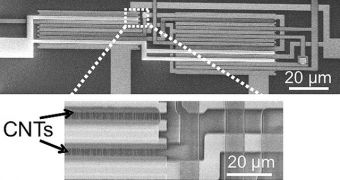Carbon nanotubes are tubular molecules of pure carbon, composed of hexagonal units of SP2 bonded carbon atoms. Researchers from the Stanford University, California, have figured out how to build them without turning the IT manufacturing industry upside down.
Carbon nanotubes (CNT) were first observed in 1991 and have since been hypothesized to be usable in pretty much everything (body armor, curing cancer, etc.).
Unfortunately, the ideas haven't really come all that far ever since scorched carbon soot exposed their existence.
That's because a method of manufacturing them cost-effectively had to be developed before anything else. Stanford researchers claim to have achieved that, or to have eliminated the need.
CNT circuits are very efficient when acting as semiconductors, not to mention extremely strong.
Actually making such circuits is hard though, or used to be until the aforementioned researchers developed some tricks.
They “ignore” two common kinds of flaws in nanotube designs (misaligned and mis-positioned CNTs). They have also invented a process that skips metallic CNTs.
Sure, the method probably isn't perfect, but it does allow existing manufacturing technologies to be used in the production of CNTs.
"The first CNTs wowed the research community with their exceptional electrical, thermal and mechanical properties over a decade ago, but this recent work at Stanford has provided the first glimpse of their viability to complement silicon CMOS transistors," stated research professor Larry Pileggi from Carnegie Mellon University.
CNTs are competing with Graphene and other materials for next-generation low-power “super” circuits. Desktops, servers and quantum computers might pair them with memristors and even quantum storage when the time comes.
"Many researchers assumed that the way to live with imperfections in CNT manufacturing was through expensive fault-tolerance techniques.," said Sachin S. Sapatnekar, editor-in-chief, IEEE Transactions on CAD.
"Through clever insights, Mitra and Wong have shown otherwise. Their inexpensive and practical methods can significantly improve CNT circuit robustness, and go a long way toward making CNT circuits viable."

 14 DAY TRIAL //
14 DAY TRIAL //